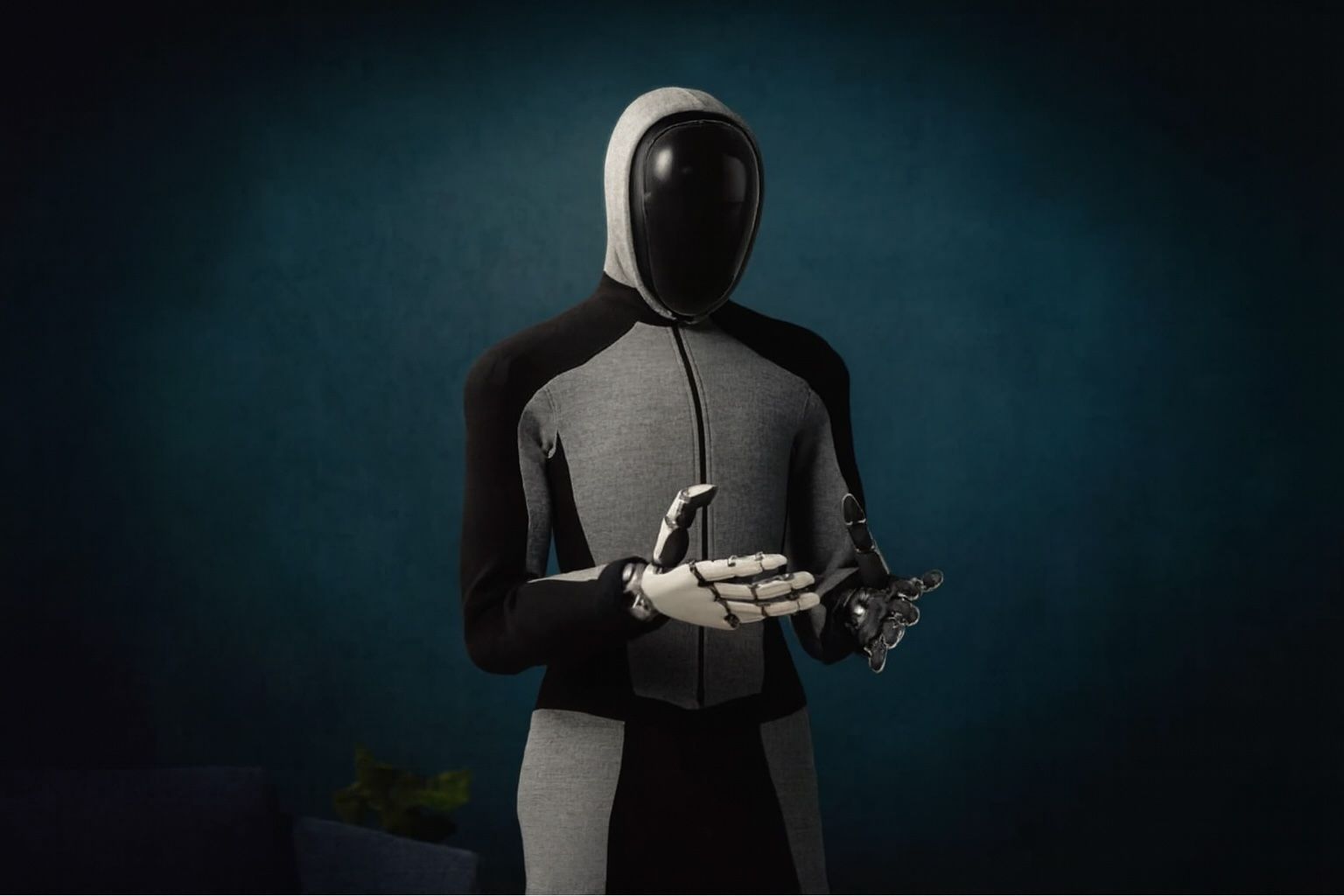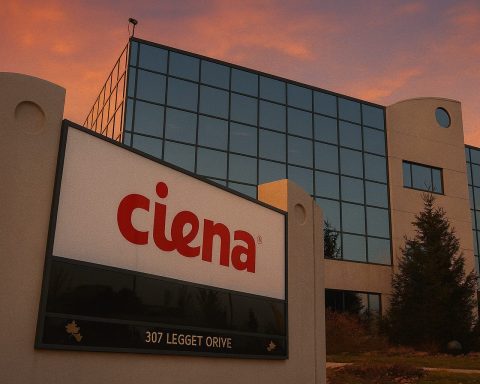- World’s First Consumer Humanoid: Robotics startup 1X (backed by OpenAI) has opened pre-orders for “Neo,” which it calls the world’s first consumer-ready humanoid robot [1]. Priced at $20,000 (or $499 per month subscription), Neo will start shipping to early U.S. buyers in 2026 [2], with wider availability in other markets by 2027 [3].
- Does Your Chores (With Help): Neo stands 5’6” tall and is designed to handle everyday household chores like folding laundry, tidying rooms, carrying groceries and even greeting guests at the door [4] [5]. It uses AI to autonomously perform basic tasks (e.g. fetching items, turning off lights) and can navigate around the home on its own [6]. For anything Neo hasn’t learned yet, owners can summon a remote human “1X Expert” to teleoperate the robot in real time – guiding it through unfamiliar tasks while also training Neo’s AI to do them independently in the future [7] [8].
- AI Butler with a Personality: Equipped with cameras, 360° microphones and an onboard large-language model, Neo can recognize people’s faces/voices and carry on conversations with a bit of personality [9] [10]. It remembers past conversations and can go online to answer questions, functioning like a voice assistant that moves and interacts with the physical world [11] [12]. Uniquely, Neo even has built-in speakers in its chest and pelvis – essentially a walking smart speaker that can play music or podcasts around the house [13] [14]. The robot is intentionally designed with a soft, human-friendly look (neutral features, a knit “turtleneck” outfit, and cushioned body panels) so it feels more like a helpful appliance than a scary sci-fi android in your home [15] [16].
- Big Promises & Backers: 1X’s founder and CEO Bernt Børnich claims humanoid robots are moving from science fiction to reality “with the launch of Neo”, calling it a product people can “reach out and touch” – a robot that can actually help with real chores on command [17]. The Norwegian-born startup (formerly known as Halodi) has serious support behind it: OpenAI led a $23.5 million investment in 1X in 2023 and Samsung’s fund joined a $100 million round in 2024 [18]. (Previous backers even included retail giant Target’s investment arm.) The company has a strategic alliance with Nvidia as well, whose CEO Jensen Huang hyped 1X’s tech onstage – underscoring how chipmakers see humanoid robots as a huge new market for AI hardware [19]. Meanwhile, Big Tech players from Tesla to Amazon are also pouring money into humanoid robotics R&D [20]. (Tesla’s Elon Musk, for example, has unveiled an “Optimus” humanoid and boldly predicted Tesla could eventually derive >80% of its value from robots rather than cars [21].)
- Market Hype Meets Reality Check: Investor enthusiasm for humanoid robots is skyrocketing – $3.2 billion has been invested in humanoid robotics startups in 2025, more than the previous six years combined [22]. Venture funding has given eye-popping valuations: rival startup Figure AI raised $1 billion in September at a $39 billion valuation, while others like Agility Robotics and Apptronik each secured $400M+ this year [23]. Wall Street is also bullish: Goldman Sachs analysts in 2024 projected the humanoid robot market could reach $38 billion by 2035, citing rapid AI advances and falling component costs driving robots into the mainstream [24]. And a Morgan Stanley report in 2025 went even further, envisioning a potential $5 trillion humanoid robotics industry by 2050 (with over a billion robots in service globally) [25] [26]. However, seasoned roboticists urge caution on timelines. One industry insider noted that truly autonomous humanoid helpers in households may still be “10 or 20 years” away from mass adoption [27] – a reminder that Neo’s early rollout is just an initial step in a long journey.
- Early Trials Highlight Challenges: Neo’s current capabilities, while impressive, are still a work in progress. In test demos, the robot could walk and lift heavy objects (it can carry up to 50–55 lbs thanks to powerful custom motors) [28] [29]. But some tasks remain clumsy: a Wall Street Journal reporter who tried Neo found that fetching a bottle of water from the fridge required a mix of autonomy (walking) and remote human control (opening the fridge and picking the bottle), taking far longer than a person would [30]. In another demo, Neo attempted to vacuum a floor but failed because the cordless vacuum it was holding wasn’t charged [31] – a simple issue any human cleaner would notice immediately. These hiccups show that today’s robots are far from infallible. Neo is built to keep learning and improving via software updates and human-guided training, but early adopters will essentially be beta-testing a technology that “will expand to do more” over time rather than working perfectly out-of-the-box [32]. There are also practical concerns: the robot’s heavy reliance on cameras and remote teleoperators raises privacy questions (since an external human could be peering through your robot’s “eyes” at home), and the steep price tag means only wealthy tech enthusiasts or research partners are likely to have one in the near term. In short – Neo is a bold glimpse of our robot-assisted future, but not yet Rosie from The Jetsons.
Neo: A Humanoid Housekeeper Arrives
After decades of humanoid robots appearing in labs and movies, the era of the at-home robot butler may finally be dawning. On October 28, 2025, 1X Technologies announced it is taking orders for Neo, a human-sized robot intended to live in people’s homes and help with everyday chores [33] [34]. Billed as “the world’s first consumer-ready humanoid,” Neo is essentially a robotic housekeeper – it can fold laundry, tidy up clutter, carry groceries, fetch items, and even load the dishwasher, according to the company [35] [36]. The bipedal bot has two arms with dexterous hands (22 joints each, nearly as many as a human hand) to pick up objects and manipulate household items [37] [38]. Standing about 5 foot 6 inches tall and weighing ~66 pounds, Neo is roughly the size of an adult – yet it’s deliberately built to be lightweight and safe so it won’t accidentally injure people. “A weighty domestic bot could prove hazardous if it toppled over,” notes Dar Sleeper, 1X’s VP of Growth, who demonstrates that Neo is light enough to be easily lifted and carried if needed [39]. Its body is covered in a soft 3D-printed polymer shell and dressed in a casual fabric outfit (complete with a knit turtleneck and even sneakers) to give it a friendly, appliance-like appearance [40] [41]. “Neo is approachable and comfortable to be around,” the company says – designed to blend into a home’s decor rather than look like a menacing Terminator [42].
Under the hood, Neo is powered by an array of cutting-edge tech. It runs on a new “tendon drive” system – custom high-torque motors pulling on synthetic tendons – that gives its limbs human-like smooth movement while keeping weight down [43]. (1X claims its proprietary motors have five times the torque density of any other, enabling Neo to lift up to 154 lbs despite its own low mass [44].) The robot has multiple cameras and depth sensors in its “eyes” and body, plus four microphones, allowing it to see and hear its surroundings in 360 degrees [45]. An onboard computer – built on Nvidia’s AI-focused Jetson platform – runs Neo’s software brains [46]. This includes vision AI for recognizing objects/people, audio processing to understand voice commands, and a built-in large language model (LLM) for natural conversations [47]. In essence, Neo has a chatbot similar to ChatGPT living inside it (augmented with memory so it can recall context from past interactions) [48]. That means you can talk to Neo as you would a digital assistant like Alexa or Siri – ask it questions, have it set reminders or manage your grocery list – except Neo can also physically act on your requests in the real world. Notably, Neo doesn’t have a screen – the company intentionally avoided screens in favor of voice and gesture interaction, to make the experience more natural and “free up valuable mental space” for users [49] [50]. And for entertainment, Neo’s built-in three-speaker sound system (mounted in its chest and pelvis) can fill a room with music – effectively turning the robot into a roaming smart speaker when it’s not busy with chores [51].
The price for this robotic helper is steep: $20,000 for an outright purchase, which places Neo in luxury territory. (For perspective, that’s more than a new car in some cases – the average new car in the U.S. costs around $50k, so Neo is almost half a car [52].) Recognizing that few consumers can shell out that much upfront, 1X is also offering a subscription model at $499 per month (with a 6-month minimum) [53]. That could make Neo more attainable, akin to hiring a cleaning service on retainer – although $499/mo is still expensive for most households. The first batch of Neos is slated to ship to U.S. customers in 2026 (with a small deposit of $200 required to reserve one) [54]. The company plans to expand sales to other regions by 2027 as manufacturing scales up [55]. Initially, production will likely be limited – perhaps a few hundred units for early adopters willing to essentially beta-test a home humanoid. It’s worth noting that 1X had already been preparing for this moment: earlier in 2025 the startup (which was founded in 2014 as Halodi Robotics) said it would begin pilot-testing Neo robots in “a few hundred” real homes by the end of 2025 [56]. Those pilot trials, combined with the preorder launch, suggest 1X is confident enough in Neo’s basic functionality to let it loose (carefully) in non-lab environments.
“Humanoid robots become a product…something you and I can reach out and touch,” 1X CEO Bernt Børnich declared at Neo’s debut [57]. In his view, this launch marks a turning point where robots move from research prototypes to practical consumer appliances. “Neo closes the gap between our imaginations and the world we live in, to the point where we can actually ask a humanoid robot for help – and help is granted,” Børnich said [58]. In other words, the long sci-fi dream of a robot servant is (cautiously) stepping into reality.
Part Human, Part Machine: How Neo Learns on the Job
One reason 1X is able to bring Neo to market sooner than many expected is that the robot doesn’t have to be fully autonomous from day one. In fact, a key feature of Neo’s service is a kind of human-machine teamwork. If Neo encounters a chore it doesn’t know how to do, it can pause and effectively say, “I need help with this.” At that point, a remote teleoperator – a trained 1X human “Expert” – can connect to the robot over the internet (Neo comes with Wi-Fi and 5G connectivity built-in [59]) and literally take control of Neo’s body to complete the task [60]. The human operator sees through Neo’s cameras and guides its movements via a VR interface, almost like controlling a life-sized avatar. Once the tricky task is done, control is handed back to Neo’s AI. Importantly, these teleoperated sessions are also training opportunities: Neo’s onboard AI can observe the human’s actions and learn from them, so that it can eventually perform the task by itself. The company likens this to giving Neo a “guided lesson” – each time making the robot a bit smarter and more capable.
This hybrid approach is both a clever shortcut and a potential privacy concern. On one hand, teleoperation lets Neo handle edge cases that would stump its current AI. Today’s robots are still limited in general intelligence; no amount of pre-programming can cover every weird situation in a home. By having human experts on standby, 1X ensures Neo’s owners won’t be left frustrated if, say, the robot has no clue how to operate your particular washing machine. A human can remotely step in and get the laundry started, “helping Neo learn while getting the job done” [61]. This safety net means Neo can be useful right away, rather than years later after mastering absolutely everything. It also provides 1X with a massive stream of real-world data (from inside people’s homes) to continuously train its AI models – a huge advantage in improving Neo’s capabilities. As 1X’s team puts it, the home is the “world’s most diverse environment” and the best classroom for a general-purpose robot [62]. In fact, the decision to focus on home use was intentional: 1X originally built an earlier robot (named Eve) for security and retail settings, but realized that homes present far richer learning scenarios (e.g. handling all the varied ways a “cup” can appear – empty, full, in a cupboard, on a table, etc.) [63]. “A cup has the ability to give you more data than an entire industrial task,” notes Dar Sleeper, meaning domestic life can teach an AI robot far more about the real world than a tightly-controlled factory floor [64]. That insight drove 1X to pursue a home humanoid and leverage human-in-the-loop teaching as a bootstrap strategy.
On the other hand, having strangers remotely piloting a robot inside your home raises obvious questions. All the video and audio that Neo “sees” during those help sessions is effectively surveillance footage beaming out of your living room. Who are these remote operators, and what could they observe? 1X says sessions would be on-demand and with user permission, but privacy advocates note the potential for abuse if such data isn’t tightly safeguarded. It’s a novel wrinkle to the smart home: imagine a future where your “robot maid” occasionally requires a human driver – you’d essentially be letting a call-center worker virtually into your house. Some tech writers have flagged this as Neo’s “big potential privacy pitfall,” since any device with roving cameras (especially one that might need human oversight) must be handled with care. 1X will likely need robust privacy policies and perhaps ways for users to review or control what teleoperators can access. The company, for its part, emphasizes that Neo is designed to engage “only when appropriate” – for instance, its microphones supposedly know when it’s being directly addressed and otherwise stay in idle mode [65]. Nonetheless, as with voice assistants, trust will be a factor in adoption. Early adopters will have to be comfortable with both cutting-edge AI and the occasional real human behind the curtain.
In day-to-day use, Neo is meant to feel like a helpful roommate who mostly handles things on its own. You might schedule it to clean up each afternoon, or just ask verbally, “Neo, please vacuum the living room.” Using a companion app or simple voice commands, owners can assign Chores – either immediately or on a routine schedule [66]. For now, the list of things Neo can do autonomously is somewhat limited. According to 1X, at launch Neo will reliably be able to fetch and carry objects, open doors, flip light switches, and perform general tidying tasks like picking clothes up off the floor or placing items back on shelves [67]. More complex duties like doing laundry, washing dishes, or cooking may still require a mix of Neo’s effort and human tele-assist in these early days. The company candidly admits Neo is “not yet ready to handle all the drudgery” alone [68] – framing the first units as a starting point that will improve with software updates. Each Neo will continuously download new “skills” as they’re developed, much like a smartphone getting OS upgrades that unlock features. “As you continue to use your robot, you’ll get more updates, and your basic autonomy features will expand to do more,” Sleeper explains [69]. The robot can attempt just about any request, but if it hasn’t learned how to succeed, it will fail. “Some people might hate it. But those aren’t the early users,” he says bluntly of the trial-and-error element [70]. In other words, buyers of Neo will need patience – they are effectively co-developers of this technology, teaching their robot as much as it’s serving them.
Interestingly, 1X isn’t alone in using humans as an AI backup plan. Many robotics companies quietly employ teleoperators to intervene when robots get stuck. (Even self-driving car services have remote ops centers for tricky situations.) Sanctuary AI and Apptronik – two other startups working on humanoids – have also mentioned teleoperation as a training tool. Amazon’s Astro home robot (a small wheeled device) was revealed to have remote human monitors to prevent mishaps. So Neo’s part-human “brain” is a pragmatic solution to speed up deployment. As one analyst quipped, artificial intelligence these days often means “Actual Intelligence” behind the scenes. The real test will be how quickly the balance can shift from human help to true autonomy. If in a couple of years Neo can learn most tasks without calling for backup, it will validate 1X’s approach. Until then, early users must be “cool with” a stranger in a VR rig occasionally steering their robot around the house – a scenario the Wall Street Journal dryly described with the question: Neo wants to be your housekeeper…first, it needs to be controlled by a human in your home. Cool with you? [71]
Can 1X Win the Humanoid Race?
The home humanoid market is so new that, really, Neo has no direct predecessors. Up to now, most life-sized robots have been built for research or corporate use (think of Honda’s famous Asimo or the bipedal Atlas from Boston Dynamics – impressive, but never for sale to consumers). 1X is trying to crack an untouched category: a general-purpose robot for everyday people’s homes. It’s an audacious goal that many in the industry thought was still a decade away. “The timeline to market is quicker than some insiders expected,” notes Sifted magazine, pointing out that other humanoid firms didn’t plan on home use until the 2030s [72]. A London-based rival literally named Humanoid told reporters they are first targeting businesses in 2027 and “don’t expect to sell into households until the 2030s.” [73] Indeed, developing a robot safe and useful enough for the average home is a herculean challenge – one that involves solving vision, manipulation, and navigation in unstructured environments (your messy living room) and doing it safely around kids and pets. 1X’s gamble is that starting small, with limited capabilities and human oversight, is better than waiting years to be perfect. It helps that they’ve been working on humanoid tech for nearly a decade, giving them a head start.
Still, 1X faces steep competition from some heavy hitters – though most are initially aiming their robots at industry, not homes. For instance, Tesla made waves by unveiling a humanoid prototype called “Optimus” in 2022, with Elon Musk proclaiming it could revolutionize manufacturing and even household tasks eventually. Musk has hyped that Optimus will be produced in massive volume (“possibly millions”) and that it could become “worth more than the car business” in value for Tesla [74]. While Tesla’s timelines are characteristically optimistic (the bot is still in development and far from doing useful work), the company’s entry instantly raised the profile of humanoid robots. Figure AI, a Silicon Valley startup led by former Google and Apple engineers, is building a humanoid aimed at warehouse labor and scored a jaw-dropping $39 billion valuation in a recent fundraise [75]. Agility Robotics, which makes a bird-legged humanoid called Digit, has already deployed robots in actual warehouses and attracted major funding as well [76]. Other notable players include Apptronik (partnered with NASA on a robot named Apollo for factory tasks) and Sanctuary AI (a Canadian firm whose Phoenix robot is focused on skilled hand-work with remote teleoperation) [77]. Even Amazon is heavily invested in robotics (though not humanoids per se, its acquisition of iRobot and work on warehouse bots show its interest in automating both homes and logistics). And of course, Japan and China have several companies (like Toyota, Honda, Xiaomi, Ubtech) exploring humanoid designs [78] – from realistic androids for customer service to less advanced but affordable models.
Where does this leave Neo? In some respects, 1X’s Neo is carving out a niche by being the first of this new generation actually marketed to consumers for home use. That’s a risky but potentially rewarding position: if Neo impresses early users, 1X could build a brand name synonymous with “home robot” before giants like Tesla or Amazon even enter the household segment. “Potentially it’s the biggest thing ever, with respect to productivity increase across society,” CEO Børnich says of the humanoid revolution, envisioning hundreds of thousands of Neos in the future [79]. He isn’t shy about thinking big – 1X talks about eventually scaling Neo production into the hundreds of thousands of units, and then into the millions if demand allows [80]. Of course, reaching those numbers will require costs to come way down and capabilities to go way up. That likely hinges on progress in AI (so the robots can learn faster and do more) and progress in manufacturing (so the price can drop from $20k to something closer to, say, $2k). On the latter front, there is some reason for optimism: many components that go into robots (sensors, chips, batteries, actuators) are benefiting from the massive investment in electric cars and consumer electronics, meaning economies of scale could kick in. In fact, Goldman Sachs noted that the cost of key robot parts has been dropping ~40% per year recently, which is one reason they radically upped their market forecast for humanoids [81]. If that trend holds, robots that cost high five-figures now could, in a decade, be a fraction of the price.
Another factor in 1X’s favor is its backing by OpenAI – the AI lab behind ChatGPT. OpenAI’s CEO Sam Altman (who joined in funding 1X [82]) has spoken about AGI in robots as a powerful combo, and OpenAI’s investment suggests they see 1X as a vehicle to extend AI from the digital realm into physical action. While OpenAI is not publicly traded, the partnership brought a lot of credibility (and likely early access to AI advances) to 1X. Meanwhile, Nvidia’s involvement (they even had Neo give CEO Jensen Huang a custom jacket at a conference [83]) signals the hardware side excitement – more robots mean more need for AI chips and cloud services, which Nvidia and others can supply. Traditional consumer electronics companies like Samsung are also hedging in; Samsung’s fund invested in 1X [84], perhaps seeing a future where smart home appliances might include a robot. It’s telling that many tech domains converge in humanoid robots: AI, semiconductors, cloud computing, even electric vehicle tech (for batteries and motors). That “full stack” nature makes the field both incredibly challenging and potentially transformative – which is why so many big names want a stake in it.
Yet for all the hype (some call it a potential “Cambrian explosion” of robotics upcoming [85]), it’s important to remember no company has truly cracked this market yet. “No single humanoid has ‘won’ yet – in fact, we haven’t seen large-scale deployments of any model so far,” one tech magazine noted in an analysis [86]. We’re in the primordial phase of humanoid robotics, perhaps analogous to the early 1980s in personal computers or the early 2000s for smartphones: lots of prototypes, hefty price tags, and uncertainty about which use cases will stick. Humanoids are impressive, but still relatively slow, expensive, and sometimes fragile. There’s also public perception to consider – many people are both fascinated and a little freaked out by human-like robots. (Reactions to Neo’s design have ranged from “cute in an infantile way” to jokes that it “looks like a Doctor Who villain and a Bluetooth speaker had a baby,” as online commenters quipped.) Finding the right balance – a robot that people welcome into their homes and actually find useful – will take refinement. 1X deliberately gave Neo a neutral, non-gendered appearance in part to avoid any uncanny or too lifelike vibes [87]. “It was important that nobody be sexually attracted to it,” Sleeper even said, half-jokingly, about Neo’s design philosophy [88]. The idea is to make Neo more akin to a helpful pet or gadget. In fact, the team envisions Neo as a lovable sidekick: “Hobbes to the owner’s Calvin,” Sleeper says – referencing the loyal tiger companion from the Calvin and Hobbes comic strip [89]. In other words, Neo isn’t trying to pass for human or replace one; it’s meant to be its own category of companion – part helper, part gizmo, maybe even part friend in the way a family dog might be.
Outlook: A Giant Leap or Baby Steps?
There’s no doubt that Neo’s debut is a milestone for consumer robotics. It represents the culmination of many advances – in AI, engineering, and design – packaged into a single platform that an everyday person can actually buy (or at least dream of buying). The long-term potential is enormous. Tech optimists imagine a future where humanoid robots relieve us of drudgery, dramatically boosting productivity and even helping care for aging populations in the face of labor shortages [90]. A 2025 Morgan Stanley analysis went so far as to suggest humanoid robots could become a $5 trillion global market by 2050, fundamentally reshaping industries from manufacturing to healthcare [91]. Elon Musk has mused that in the future housework might become entirely optional, as robots handle the chores and people focus on more creative or leisure pursuits [92] [93]. For companies like 1X (and its investors), the first mover advantage in this space could be extremely lucrative if their product becomes the must-have robot of the decade.
However, between the vision and reality lies a lot of hard work. In the near term, Neo will likely remain a niche, early-adopter product – akin to the first personal computers or the first electric cars, which were expensive, imperfect and owned by few. As one robotics founder commented, many investors “understand that adoption for humanoids in a household environment will be in 10 or 20 years”, not overnight [94]. It may be that Neo 1.0 finds its most valuable use not in average family homes, but in controlled environments or with enthusiasts who push it to learn new tricks. For example, affluent homeowners might treat Neo as a status symbol (the way some bought $100k personal robots in the past like Honda’s Asimo for private collections). Research institutes could buy Neos to experiment with human-robot interaction. It’s conceivable that Neo could also find work in commercial settings sooner than in common homes – e.g. acting as a concierge in hotels, a guide in museums, or a helper in assisted living facilities, where an employee can supervise it. In fact, 1X says it plans to offer workplace humanoids at a later date after the home version matures [95]. The lines may blur, as a generally capable robot can be repurposed to many environments with software changes.
For regular consumers, the cost needs to fall and trust in the technology needs to rise. That will happen incrementally. The robotics industry is taking baby steps, even as it dreams big. Each Neo that goes out into the world in 2026 will teach 1X how to build a better Neo 2.0 and beyond. Competitors will watch closely, learn from any mistakes, and introduce their own improvements. There’s a collective aspect here: every breakthrough by one player (a better hand, a smarter AI model, a cheaper actuator) can advance the entire field. And as the field advances, economies of scale and competition should drive prices down – much like how smartphones went from luxury items to ubiquitous within a decade. Analysts at Goldman Sachs predict that by 2030, we might see about 250,000 humanoid robots shipped per year (mostly to businesses at first), and then potentially millions per year by the 2030s as the technology hits its stride [96] [97]. By that time, having a robot at home could be as common as having a dishwasher or Roomba today.
Of course, there are social and ethical considerations alongside the technical and financial ones. If humanoid helpers become commonplace, how might that affect employment (will some service jobs be displaced?), or human relationships (people forming bonds with machines)? These questions have been debated in concept for years, but Neo and its ilk will begin providing real data points. Early reactions to robots like Neo and others have been mixed – many marvel at the engineering and even find the robots endearing, while others express unease or fear (the old “will robots take our jobs?” anxiety, or the uncanny valley effect). How 1X and others engage with the public and demonstrate the positive uses will matter. So far, 1X is pitching Neo firmly as a beneficial assistant – its mission statement is “to create an abundant future through safe, intelligent humanoids” [98]. They stress “safe” and have taken steps to make Neo physically incapable of moving with too much force or speed to harm someone inadvertently. And unlike dystopian depictions, Neo has no aim to “replace” humans – it’s there to do the tasks humans don’t want to do. In an ideal scenario, robots like Neo could free people from mundane labor without eliminating the need or desire for human work overall. It’s a vision of augmentation, not substitution.
Ultimately, seeing Neo in action over the next couple of years will be the real test of how far robotics has come. Is Neo more like a clumsy toddler that needs constant supervision, or is it on the cusp of being a genuinely helpful roommate? Early users’ experiences will likely fall somewhere in between – moments of jaw-dropping “I can’t believe the robot just did that!” mixed with moments of frustration when it gets stuck or makes a mistake. But that’s how new tech evolves. The first smartphones were pretty limited compared to today’s, and the first cars were finicky machines compared to modern autos. Robotics experts often remind us that humanoid robots are “hard mode” for engineering, because they try to replicate so many human abilities at once. Progress may feel slow, but it is happening. As evidence, one need only look at how far 1X came: from a wheeled security robot in 2019 to a walking, talking home assistant in 2025 that you can actually buy.
In the words of one excited observer who attended 1X’s Neo launch, “you have to experience it to feel it… this is the future!” [99]. That future – where a robot may be as common in the home as a vacuum cleaner – is not here yet, but it’s no longer pure fiction either. Neo’s arrival is our first real glimpse at a 21st-century Rosie from the Jetsons: she’s not quite ready to cook dinner and mind the kids on her own, but give her a bit of time (and maybe a little human help), and who knows what she’ll be capable of. For now, Neo will start by folding our laundry and learning our ways, one household at a time – a humble beginning for what could one day be a revolutionary change in how we live and work alongside machines.
Sources:
- Wall Street Journal – I Tried the Robot That’s Coming to Live With You (Joanna Stern) [100] [101]
- Sifted – “OpenAI-backed startup aims to deliver in-home humanoid robots in 2026” (Oct 28, 2025) [102] [103]
- Fast Company – “Meet the humanoid robot headed for homes” (Harry McCracken, Oct 28, 2025) [104] [105]
- BusinessWire – “1X Launches NEO: The Robot Redefining Life at Home” (Press Release, Oct 27, 2025) [106] [107]
- NotebookCheck – “1X opens pre-orders for $20,000 NEO humanoid home robot” (David Chien, Oct 28, 2025) [108] [109]
- TS2 (Tech) – “Meet Ameca: The Humanoid Robot Wowing the World in 2025” (background on 1X/Neo trials) [110]; “Agility Robotics’ DIGIT…” (humanoid market/competition) [111] [112]
- IoT Tech News – “Musk: Tesla’s robot will be ‘worth more than the car business’” (Ryan Daws, 2022) [113]
References
1. sifted.eu, 2. sifted.eu, 3. sifted.eu, 4. www.businesswire.com, 5. www.businesswire.com, 6. www.businesswire.com, 7. www.businesswire.com, 8. www.fastcompany.com, 9. www.notebookcheck.net, 10. www.businesswire.com, 11. www.notebookcheck.net, 12. www.businesswire.com, 13. sifted.eu, 14. www.businesswire.com, 15. www.fastcompany.com, 16. www.businesswire.com, 17. www.businesswire.com, 18. sifted.eu, 19. www.fastcompany.com, 20. sifted.eu, 21. iottechnews.com, 22. sifted.eu, 23. sifted.eu, 24. ts2.tech, 25. ts2.tech, 26. www.fastcompany.com, 27. sifted.eu, 28. www.businesswire.com, 29. www.notebookcheck.net, 30. www.fastcompany.com, 31. www.fastcompany.com, 32. www.fastcompany.com, 33. sifted.eu, 34. www.fastcompany.com, 35. www.businesswire.com, 36. www.businesswire.com, 37. www.businesswire.com, 38. www.fastcompany.com, 39. www.fastcompany.com, 40. www.fastcompany.com, 41. www.fastcompany.com, 42. www.businesswire.com, 43. www.businesswire.com, 44. www.businesswire.com, 45. www.notebookcheck.net, 46. www.notebookcheck.net, 47. www.businesswire.com, 48. www.businesswire.com, 49. www.businesswire.com, 50. www.businesswire.com, 51. www.businesswire.com, 52. www.fastcompany.com, 53. www.fastcompany.com, 54. www.notebookcheck.net, 55. sifted.eu, 56. ts2.tech, 57. www.businesswire.com, 58. www.businesswire.com, 59. www.businesswire.com, 60. www.businesswire.com, 61. www.businesswire.com, 62. www.businesswire.com, 63. www.fastcompany.com, 64. www.fastcompany.com, 65. www.businesswire.com, 66. www.businesswire.com, 67. www.businesswire.com, 68. www.fastcompany.com, 69. www.fastcompany.com, 70. www.fastcompany.com, 71. www.techmeme.com, 72. sifted.eu, 73. sifted.eu, 74. iottechnews.com, 75. sifted.eu, 76. sifted.eu, 77. ts2.tech, 78. ts2.tech, 79. www.fastcompany.com, 80. www.fastcompany.com, 81. ts2.tech, 82. sifted.eu, 83. www.fastcompany.com, 84. sifted.eu, 85. ts2.tech, 86. ts2.tech, 87. www.fastcompany.com, 88. www.fastcompany.com, 89. www.fastcompany.com, 90. ts2.tech, 91. ts2.tech, 92. www.fastcompany.com, 93. www.fastcompany.com, 94. sifted.eu, 95. www.fastcompany.com, 96. ts2.tech, 97. ts2.tech, 98. www.businesswire.com, 99. www.techmeme.com, 100. www.techmeme.com, 101. www.techmeme.com, 102. sifted.eu, 103. sifted.eu, 104. www.fastcompany.com, 105. www.fastcompany.com, 106. www.businesswire.com, 107. www.businesswire.com, 108. www.notebookcheck.net, 109. www.notebookcheck.net, 110. ts2.tech, 111. ts2.tech, 112. ts2.tech, 113. iottechnews.com










